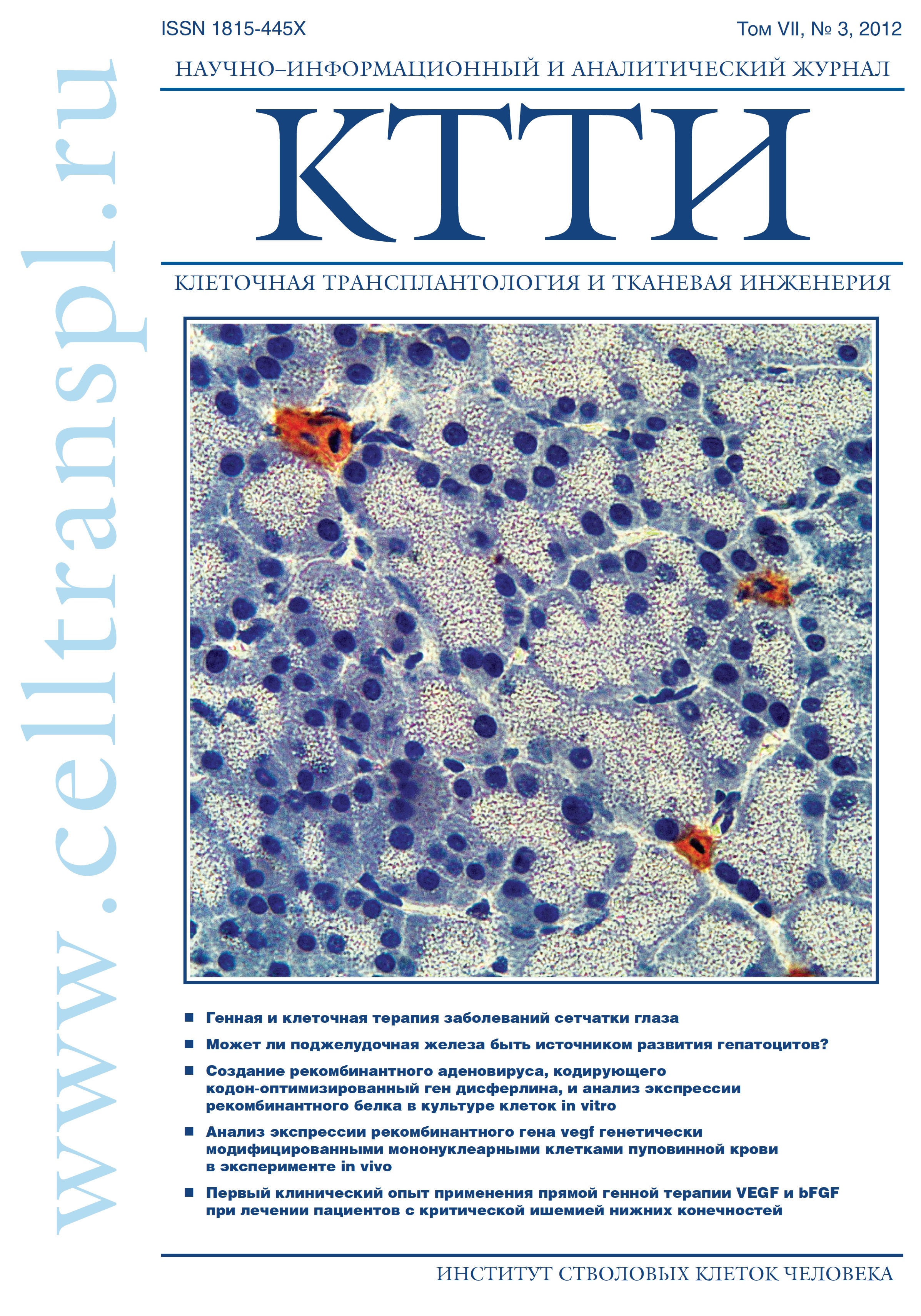Survival and differentiation of endogenous Schwann cells migrating into spinal cordunder the influence of neurotrophic factors
- Authors: Mukhamedshina YO1,2,3, Shaymardanova GF4, Muhitov AR4, Salafutdinov II2, Zarubina VN1, Rizvanov АА2, Chelyshev Y.A1,2,3
-
Affiliations:
- Кazan State Medical University, Kazan
- Кazan (Volga region) Federal University, Kazan
- Kazan Institute of Biochemistry and Biophysics of RAS, Kazan
- Issue: Vol 7, No 3 (2012)
- Pages: 125-129
- Section: Articles
- URL: https://genescells.ru/2313-1829/article/view/121635
- DOI: https://doi.org/10.23868/gc121635
- ID: 121635
Cite item
Abstract
regeneration in the peripheral nervous system. They migrate
into the injury region of spinal cord, which are involved in
remyelination and are regarded as the source of numerous
molecular signals that could potentially support the growth
of axons in the central nervous system. In the present work
we describe the behavior of migrating into the injury dosed
region spinal cord Schwann cells under the influence of
neurotrophic factors - vascular endothelial growth factor
(VEGF) and fibroblast growth factor 2 (FGF2), delivered
by direct introduction of «naked» plasmid DNA and by
transplantation of genetically modified human umbilical cord
blood mononuclear cells.
Using immunohistochemical detection of markers of S100,
GFAP, Krox20 and HSP25 identified different phenotypes
of migrating into the spinal cord of endogenous Schwann
cells. Found that greatest influence on their numbers in the
injury region provides local delivery of genes vegf and fgf2
by human umbilical cord blood mononuclear cells. However,
the direct introduction of the same plasmid may also be
promising in the case of synthetic platforms that enhance
its transfection activity.
Keywords
About the authors
Y O Mukhamedshina
Кazan State Medical University, Kazan;Кazan (Volga region) Federal University, Kazan;Кazan State Medical University, Kazan;Кazan (Volga region) Federal University, Kazan;
G F Shaymardanova
Kazan Institute of Biochemistry and Biophysics of RAS, KazanKazan Institute of Biochemistry and Biophysics of RAS, Kazan
A R Muhitov
Kazan Institute of Biochemistry and Biophysics of RAS, KazanKazan Institute of Biochemistry and Biophysics of RAS, Kazan
I I Salafutdinov
Кazan (Volga region) Federal University, KazanКazan (Volga region) Federal University, Kazan
V N Zarubina
Кazan State Medical University, KazanКazan State Medical University, Kazan
А А Rizvanov
Кazan (Volga region) Federal University, KazanКazan (Volga region) Federal University, Kazan
Yu A Chelyshev
Кazan State Medical University, Kazan;Кazan (Volga region) Federal University, Kazan;Кazan State Medical University, Kazan;Кazan (Volga region) Federal University, Kazan;
References
- Челышев Ю.А., Викторов И.В. Клеточные технологии ремие- линизации при травме спинного мозга. Неврологический вестник 2009; 41(1): 49-55.
- Frostick S.P., Yin Q., Kemp G.J. Schwann cells, neurotrophic factors, and peripheral nerve regeneration. Microsurgery 1998; 18(7): 397-405.
- Boyd J.G., Gordon T. Neurotrophic factors and their receptors in axonal regeneration and functional recovery after peripheral nerve injury. Mol. Neurobiol. 2003; 27(3): 277-324. 4. Höke A., Mi R. In search of novel treatments for peripheral neuropathies and nerve regeneration. Discov. Med. 2007; 7(39): 109-12.
- Jasmin L., Janni G., Moallem T.M. et al. Schwann cells are removed from the spinal cord after effecting recovery from paraplegia.
- J. Neurosci. 2000; 20(24): 9215-23.
- Шаймарданова Г.Ф., Мухамедшина Я.О., Архипова С.С. и др. Экспрессия молекулярных детерминант шванновских клеток и пе- риферического миелина в спинном мозге крысы при контузионной травме. Морфологические ведомости 2011; 6: 73-7.
- Cao L., Zhu Y.L., Su Z. et al. Olfactory ensheathing cells promote migration of Schwann cells by secreted nerve growth factor. Glia 2007; 55(9): 897-904.
- Hill C.E., Moon L.D., Wood P.M. Labeled Schwann cell transplantation: cell loss, host Schwann cell replacement, and strategies to enhance survival. Glia 2006; 53(3): 338-43.
- Rizvanov A.A., Guseva D.S., Salafutdinov I.I. et al. Genetically modified human umbilical cord blood cells expressing VEGF and FGF2 differentiate into glial cells after transplantation into amyotrophic lateral sclerosis (ALS) transgenic mice. Exper. Biol. Med. 2011; 236(1): 91-8.
- Haninec P., Kaiser R., Bobek V. et al. Enhancement of musculocutaneous nerve reinnervation after vascular endothelial growth factor (VEGF) gene therapy. BMC Neuroscience. In press 2012.
- Shen B., Pei F.X., Chen J. et al. Effect of controlled release microspheres incorporating bFGF on Schwann cells. Sichuan Xue Ban. 2005; 36(6): 873-6.
- Zujovic V., Thibaud J., Bachelin C. et al. Boundary cap cells are highly competitive for CNS remyelination: fast migration and Efficient differentiation in PNS and CNS myelin-forming cells. Stem Cells 2010; 28: 470-79.
- Wang J., Zhang P., Wang Y. et al. The observation of phenotypic changes of Schwann cells after rat sciatic nerve injury. Artif. Cells Blood Substit. Immobil. Biotechnol. 2010; 38(1): 24-8.
- Murashov A.K., Haq I.U., Hill C. et al. Crosstalk between p38, Hsp25 and Akt in spinal motor neurons after sciatic nerve injury. Brain Res. Mol. 2001; 93(2): 199-208.
- Pieri I., Cifuentes-Diaz C., Oudinet J.P. Modulation of HSP25 expression during anterior horn motor neuron degeneration in the paralysé mouse mutant. J. Neurosci. Res. 2001; 65(3): 247-53.
Supplementary files










